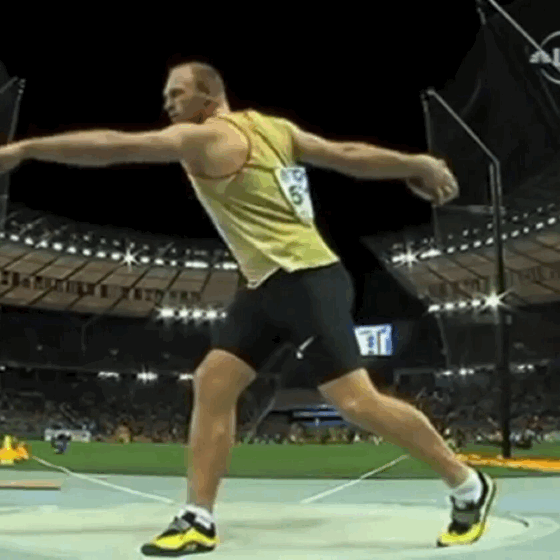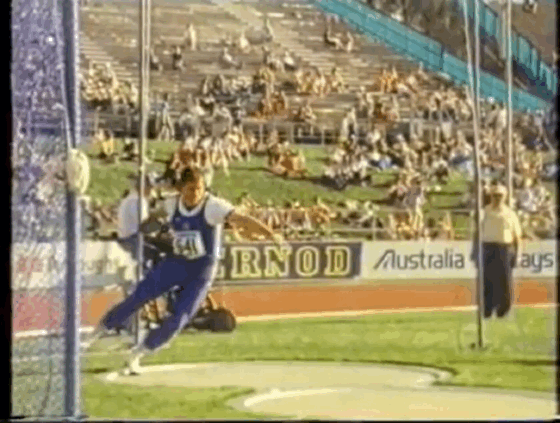Dorsiflexion of the Sweep Leg
- Throws University

- Apr 13, 2020
- 4 min read
You have heard the term “dorsiflexion” in various ThrowsU technical analysis. Not sure what it means, when it happens or even WHY it has to happen, you have ignored the principle. Curiosity has continuously piqued your interest in the topic, you scour the internet looking for a sweet article on the benefits of a dorsiflexed leg in the shot put spin or discus. Your search results fail you and the question remains unanswered...until now.
Understanding the Global Movement

As we work through this article, we will be speaking about the action of the dominant side of throwers as they work around the non-dominant leg. From here moving forward, we will refer to the leg as the right leg around the left leg and discuss the action of attaining and achieving a dorsiflexed leg. The big principles to consider initially are quite basic.
The right side moves around the left side.
The left side moves around the right side through the middle.
The right moves around the left side on the finish.
It is simply that simple. There is no need to dive into 6-10 different positions. Remember, it’s the back/middle/front broken down into sides of the throw.
Once a thrower is able to think in SIDES (right and left), it sparks a technical AHA moment where all cues seem to click. Remember our discussion on Prime Movers in relation to sides. If the right side is rotating around the left side, the right side is the prime mover. If the left side is moving around the right side, the left side is the prime mover. If the left side is holding the finish, the right side is the prime mover. Now, let’s roll with this technical epiphany and dive into dorsiflexion.

Dorsiflexion of the Right Side

When a discus thrower or shot putter enters from the back of the circle, it is quite evident that MOST elite throwers open their left side upper body out past their left knee and hip. They push tension into the ground while the left arm reaches level out wide and the left arm and chest open up past the left hip. There is an established left knee flexion that typically puts the load over the mid to forefront of the left foot.
For shot putters, the athlete will pick up the right foot as the left foot is either just prior to 90 degrees or at 90 degrees. This varies slightly with discus throwers. Most discus throwers will pick up their right foot as the left foot is at 90 degrees or past 90 degrees. The holding position of the chest, left knee and arm is important for the direction of the dorsiflexed right leg.

Try to imprint the image of the left arm of Dacres/Harting/Kovacs/Crouser/Rodhe/Walsh/Hill into your brain. Think about how wide the left arm is, how the weight is shifting over the left foot and how the beginning of rotation in the entire throw is being initiated by the left arm out of the back. Pretend there is a line being drawn from the left hand down to the concrete, in fact don’t pretend, we will do it for you! Notice the distance of the left arm away from the body is almost EXACTLY in line with the distance of the right leg.
This left arm and chest opening out of the back MUST be calculated and controlled. As the left opens, the right leg will push actively and ultimately get to a wide position AROUND the left side. This side around side principle is key for technical comprehension. In comes the right leg.
The Right Foot Dorsiflexion
Coach taught me to keep the right leg low, how can I get it that wide? Well...coach may not have been most accurate. Initially, the right leg will push around the left and the HEIGHT of the right leg at certain points will vary from elite thrower to elite thrower.

The key becomes having a right leg that is LENGTHENED and dorsiflexed. The timing is to initiate a dorsiflexed right foot AS IT PASSES the left side. This will typically lengthen the right leg. Some world-class throwers such as Simon Peterson and Daniel Stahl have a semi-flexed right leg while still holding a dorsiflexed right foot. It seems to be more advantageous for rotational physics to have a LONGER right leg that is extended in the knee with a dorsiflexed foot.

There are few key benefits to the right leg sweep being dorsiflexed.
Wider right leg = more rotational energy from a longer lever arm as it sweeps to the center.
Bigger push from foot and quad that generates energy from sweep into the groin as well.
Pick up stretch between the long left arm and grounded right foot leads to long stretch as the sweep point between the long right leg and opened left arm.
Dorsiflexion lengthens the Achilles tendon just prior to sweeping down to grounded plantar flexion, creating a stretch-shortening cycle in the Achilles.
Longer right leg sweep with a dorsiflexed right makes it easier to keep the right knee over the foot in the middle which then enables the left leg to sweep around the grounded right in the center.
Throwers will get to a lengthened, dorsiflexed right side differently based on height and mobility. It is important to recognize that Harting, Perkovic, Dacres, Kovacs, Crouser, Walsh, etc...all get to some degree of right foot dorsiflexion with an extended right knee. Proving the importance of a mobile hip girdle that can generate massive rotational energy to the center of the circle.
Recap
It’s important to understand WHAT a dorsiflexed right foot looks like before even attempting to achieve the positioning. After the concept is understood, it’s important to recognize the relationship between the left knee and left arm in regards to the right leg sweep around the left. An improved understanding of the side around side technical model will lead to incredibly strong, rotational throws!

"Our aim is to provide concise and concrete education and training on the throws, helping coaches and athletes learn what they need to do to succeed and become champions."
- Dane and Trevor



























Comments